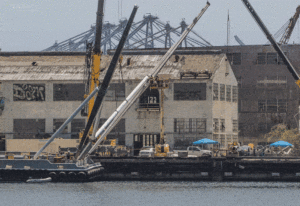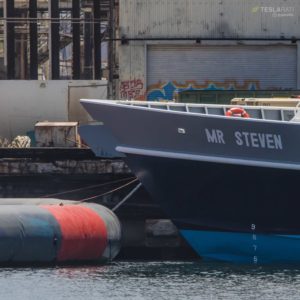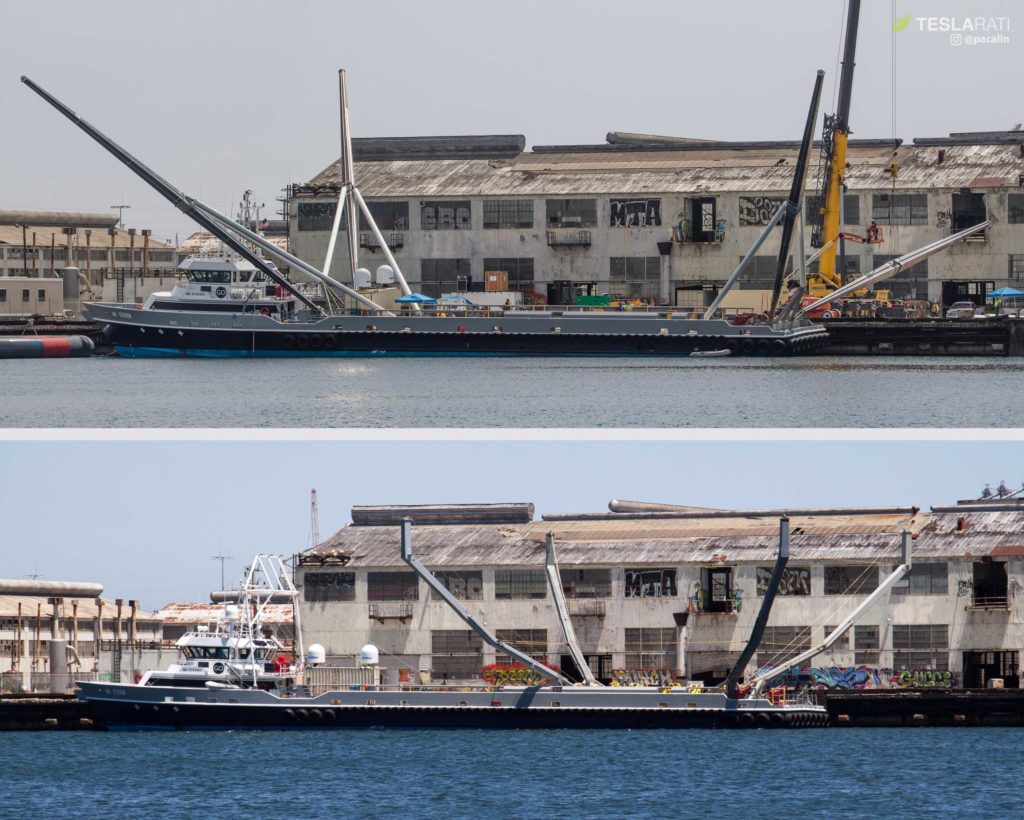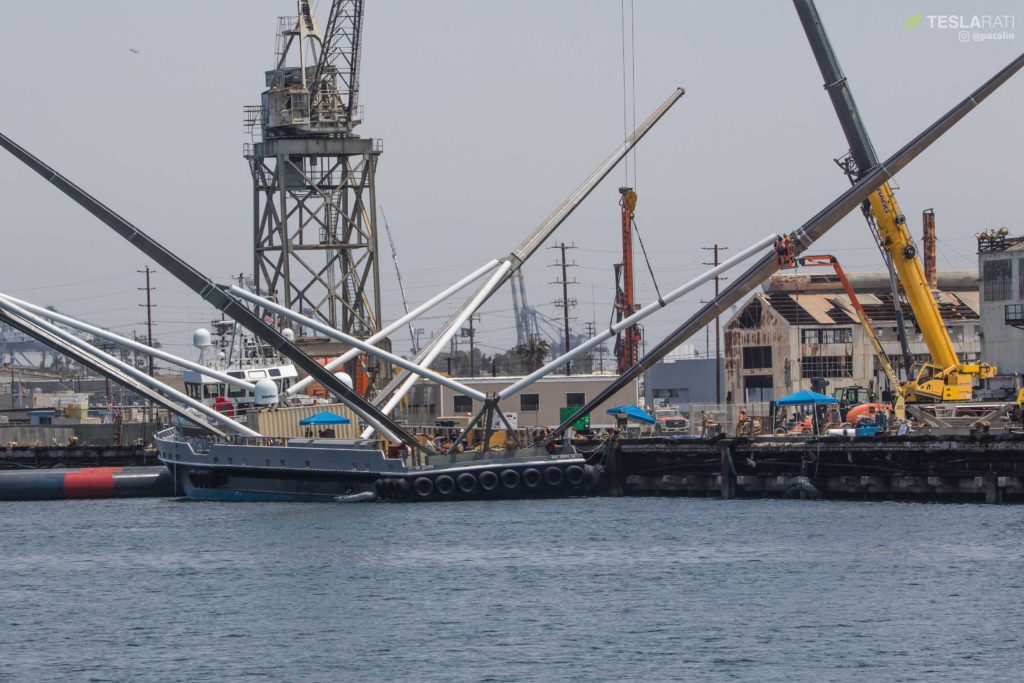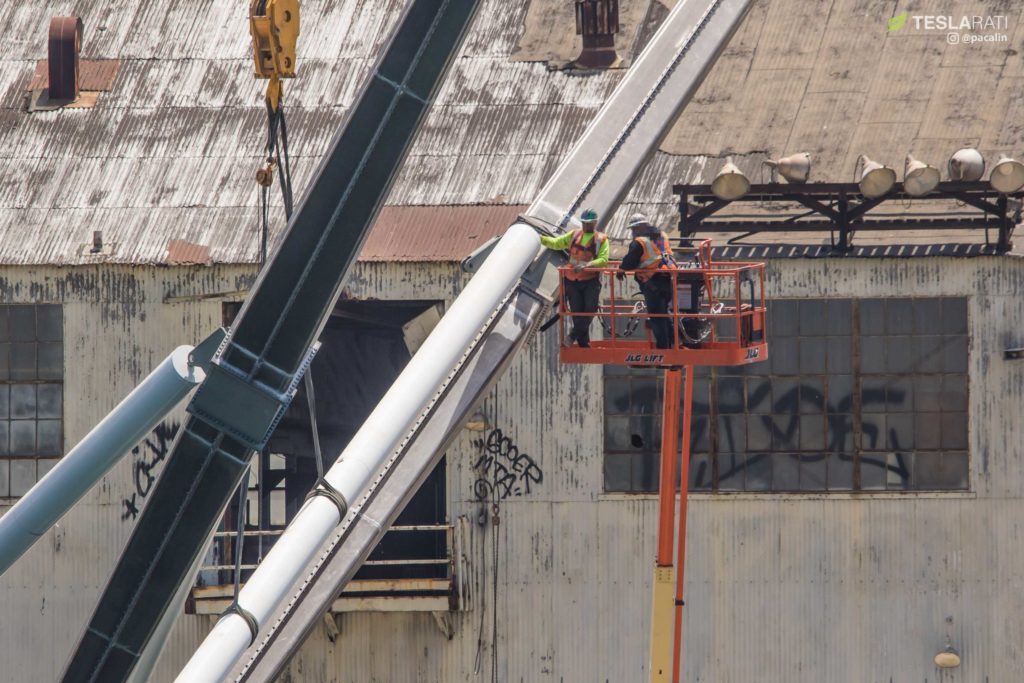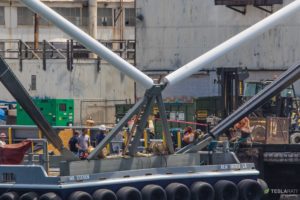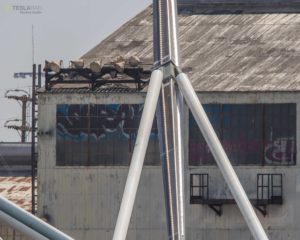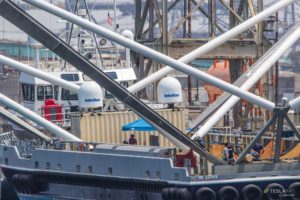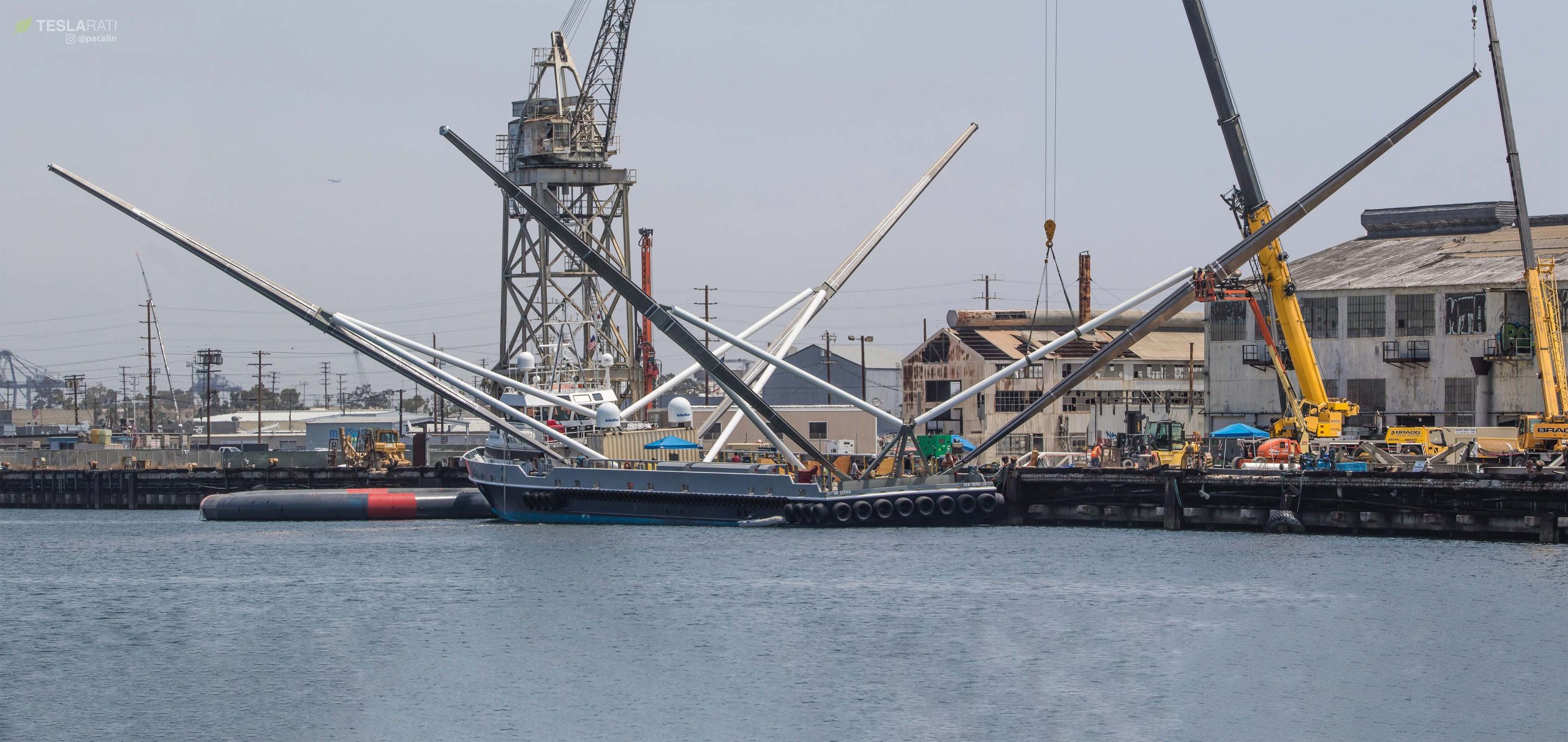
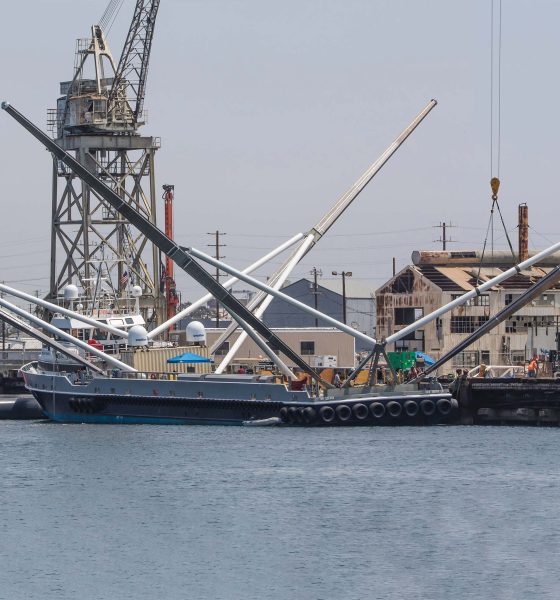
News
SpaceX completes vast Mr Steven arm upgrades for quadruple-sized net
Scarcely 48 hours after they began, SpaceX technicians have already completed installation of all four of Falcon fairing recovery vessel Mr Steven’s new and dramatically larger arms, as well as eight giant struts. All that remains to be installed is an upgraded net, said by CEO Elon Musk to have four times the area of its predecessor.
Put simply, it’s difficult to express how large these upgraded arms really are, and photos still only give a partial sense of their scale. SpaceX technicians busy installing the new arms on July 10th nevertheless offer a fleeting appreciation of the true size of this new payload fairing recovery apparatus, which will hopefully see its first operational debut in just two weeks with a fairing recovery attempt after the Iridium-7 Falcon 9 mission, July 25th.
- A few SpaceX technicians examine one of Mr Steven’s newly-attached arms and struts. (Pauline Acalin)
- Mr Steven and the ever mysterious inflatable ring now floating at Berth 240, July 10. (Pauline Acalin)
All arms on deck
While it’s difficult to estimate from photos alone, it appears that Mr Steven’s new arms are minimum of roughly 65 meters squared, assuming a square aspect ratio. In other words, the vessel’s next and newest net could have an area as large as 3600 square meters (~40,000 square feet, ~0.85 acres), easily more than quadruple the size of Mr Steven’s previous net. For comparison, the massive autonomous spaceport drone ships (ASDS) SpaceX often recovers its Falcon 9 and Heavy boosters aboard have a usable landing area of roughly 45,000 square feet, a little more than 10% larger than Mr Steven’s new net.
With these vast new arms, struts, and (soon enough) net, SpaceX is likely as close as they have ever been to successfully catching a Falcon 9 fairing, an achievement that would likely allow the company to begin reusing the large carbon fiber-composite shrouds almost immediately. Critically, although SpaceX appears to have begun attaching recovery hardware to both fairing halves in recent West Coast attempts, it remains to be seen whether Mr Steven’s new claw apparatus will be able to catch both halves, thus closing the gap on fairing recovery without necessitating the leasing and modification of perhaps three additional copies of the vessel.
- A before and after comparison of Mr Steven’s old and new arms. (Pauline Acalin)
- Even at this zoom, the human workers are difficult to make out. (Pauline Acalin)
- E N H A N C E. (Pauline Acalin)
Adding three recovery-critical ships (two for West Coast missions, two for East Coast missions) to SpaceX’s already massive blue-water fleet could significantly raise the operating costs of each recovery attempt, as well as generally adding considerable complexity to the orchestration of those fleets come launch time. Perhaps not. Still, if Mr Steven sees success with his 4Xed net and arms, chances are very good that SpaceX will lease and modify another Fast Supply Vessel – if they already haven’t done so – to provide the company’s higher-volume East Coast launch facilities with their own, dedicated fairing catcher. Mrs Steven awaits…
- A few more arm and strut glamour shots, July 10. (Pauline Acalin)
- A few more arm and strut glamour shots, July 10. (Pauline Acalin)
- Port of San Pedro or an Andrew Pollock painting? You be the judge. (Pauline Acalin)
Zeroing in on Falcon fairings
Worth noting, SpaceX may have already halved the error margin officially advertised for the parafoil guidance units it procured from Canadian supplier MMIST, apparently missing Mr Steven by about 50 meters while MMIST suggests a 50% chance of successfully landing a payload in a 100-meter sphere. Given the significant expense likely incurred by designing, building, installing, and testing two distinct net and arm systems aboard Mr Steven, it’s safe to say that SpaceX engineers and technicians believe there is a very strong chance that the newest solution will successfully close the fairing recovery gap, said by CEO Elon Musk to be a rather literal 50 meters between the vessel’s old net and the unforgiving ocean surface.
With an additional 30 meters (~100 feet) of reach in both axes, the new net alone may be able to shrink that error margin by ~60%. Perhaps the fact that it also appears to cover (and thus protect) Mr Steven’s wheelhouse will allow the vessel more leeway to aggressively maneuver as the fairing nears touchdown, providing that final 20-meter leap to slip his net under the fall halves.
In the meantime, we will ponder who exactly SpaceX is procuring a 40,000 square foot net from.

Incredibly, this artist rendering of a much larger net installed on Mr Steven was perhaps two or more times smaller than the solution now installed on the vessel. (Reese Wilson)
Follow us for live updates, peeks behind the scenes, and photos from Teslarati’s East and West Coast photographers.
Teslarati – Instagram – Twitter
Tom Cross – Twitter
Pauline Acalin – Twitter
Eric Ralph – Twitter

News
Tesla China delivery centers look packed as 2025 comes to a close
Needless to say, it appears that Tesla China seems intent on ending 2025 on a strong note.

Tesla’s delivery centers in China seem to be absolutely packed as the final days of 2025 wind down, with photos on social media showing delivery locations being filled wall-to-wall with vehicles waiting for their new owners.
Needless to say, it appears that Tesla China seems intent on ending 2025 on a strong note.
Full delivery center hints at year-end demand surge
A recent image from a Chinese delivery center posted by industry watcher @Tslachan on X revealed rows upon rows of freshly prepared Model Y and Model 3 units, some of which were adorned with red bows and teddy bears. Some customers also seem to be looking over their vehicles with Tesla delivery staff.
The images hint at a strong year-end push to clear inventory and deliver as many vehicles as possible. Interestingly enough, several Model Y L vehicles could be seen in the photos, hinting at the demand for the extended wheelbase-six seat variant of the best-selling all-electric crossover.
Strong demand in China
Consumer demand for the Model Y and Model 3 in China seems to be quite notable. This could be inferred from the estimated delivery dates for the Model 3 and Model Y, which have been extended to February 2026 for several variants. Apart from this, the Model Y and Model 3 also continue to rank well in China’s premium EV segment.
From January to November alone, the Model Y took China’s number one spot in the RMB 200,000-RMB 300,000 segment for electric vehicles, selling 359,463 units. The Model 3 sedan took third place, selling 172,392. This is quite impressive considering that both the Model Y and Model 3 are still priced at a premium compared to some of their rivals, such as the Xiaomi SU7 and YU7.
With delivery centers in December being quite busy, it does seem like Tesla China will end the year on a strong note once more.
News
Tesla Giga Berlin draws “red line” over IG Metall union’s 35-hour week demands
Factory manager André Thierig has drawn a “red line” against reducing Giga Berlin’s workweek to 35 hours, while highlighting that Tesla has actually increased its workers’ salaries more substantially than other carmakers in the country.

Tesla Giga Berlin has found itself in a new labor dispute in Germany, where union IG Metall is pushing for adoption of a collective agreement to boost wages and implement changes, such as a 35-hour workweek.
In a comment, Giga Berlin manager André Thierig drew a “red line” against reducing Giga Berlin’s workweek to 35 hours, while highlighting that Tesla has actually increased its workers’ salaries more substantially than other carmakers in the country.
Tesla factory manager’s “red line”
Tesla Germany is expected to hold a works council election in 2026, which André Thierig considers very important. As per the Giga Berlin plant manager, Giga Berlin’s plant expansion plans might be put on hold if the election favors the union. He also spoke against some of the changes that IG Metall is seeking to implement in the factory, like a 35-hour week, as noted in an rbb24 report.
“The discussion about a 35-hour week is a red line for me. We will not cross it,” Theirig said.
“(The election) will determine whether we can continue our successful path in the future in an independent, flexible, and unbureaucratic manner. Personally, I cannot imagine that the decision-makers in the USA will continue to push ahead with the factory expansion if the election results favor IG Metall.”
Giga Berlin’s wage increase
IG Metall district manager Jan Otto told the German news agency DPA that without a collective agreement, Tesla’s wages remain significantly below levels at other German car factories. He noted the company excuses this by referencing its lowest pay grade, but added: “The two lowest pay grades are not even used in car factories.”
In response, Tesla noted that it has raised the wages of Gigafactory Berlin’s workers more than their German competitors. Thierig noted that with a collective agreement, Giga Berlin’s workers would have seen a 2% wage increase this year. But thanks to Tesla not being unionized, Gigafactory Berlin workers were able to receive a 4% increase, as noted in a CarUp report.
“There was a wage increase of 2% this year in the current collective agreement. Because we are in a different economic situation than the industry as a whole, we were able to double the wages – by 4%. Since production started, this corresponds to a wage increase of more than 25% in less than four years,” Thierig stated.
News
Tesla is seeing a lot of momentum from young Koreans in their 20s-30s: report
From January to November, young buyers purchased over 21,000 Teslas, putting it far ahead of fellow imported rivals like BMW and Mercedes-Benz.

Tesla has captured the hearts of South Korea’s 20s-30s demographic, emerging as the group’s top-selling imported car brand in 2025. From January to November, young buyers purchased over 21,000 Teslas, putting it far ahead of fellow imported rivals like BMW and Mercedes-Benz.
Industry experts cited by The Economist attributed this “Tesla frenzy” to fandom culture, where buyers prioritize the brand over traditional car attributes, similar to snapping up the latest iPhone.
Model Y dominates among young buyers
Data from the Korea Imported Automobile Association showed that Tesla sold 21,757 vehicles to the 20s-30s demographic through November, compared to BMW’s 13,666 and Mercedes-Benz’s 6,983. The Model Y led the list overwhelmingly, with variants like the standard and Long Range models topping purchases for both young men and women.
Young men bought around 16,000 Teslas, mostly Model Y (over 15,000 units), followed by Model 3. Young women followed a similar pattern, favoring Model Y (3,888 units) and Model 3 (1,083 units). The Cybertruck saw minimal sales in this group.
The Model Y’s appeal lies in its family-friendly SUV design, 400-500 km range, quick acceleration, and spacious cargo, which is ideal for commuting and leisure. The Model 3, on the other hand, serves as an accessible entry point with lower pricing, which is valuable considering the country’s EV subsidies.
The Tesla boom
Experts described Tesla’s popularity as “fandom culture,” where young buyers embrace the brand despite criticisms from skeptics. Professor Lee Ho-geun called Tesla a “typical early adopter brand,” comparing purchases to iPhones.
Professor Kim Pil-soo noted that young people view Tesla more as a gadget than a car, and they are likely drawn by marketing, subsidies, and perceived value. They also tend to overlook news of numerous recalls, which are mostly over-the-air software updates, and controversies tied to the company.
Tesla’s position as Korea’s top import for 2025 seems secured. As noted by the publication, Tesla’s December sales figures have not been reported yet, but market analysts have suggested that Tesla has all but secured the top spot among the country’s imported cars this year.
